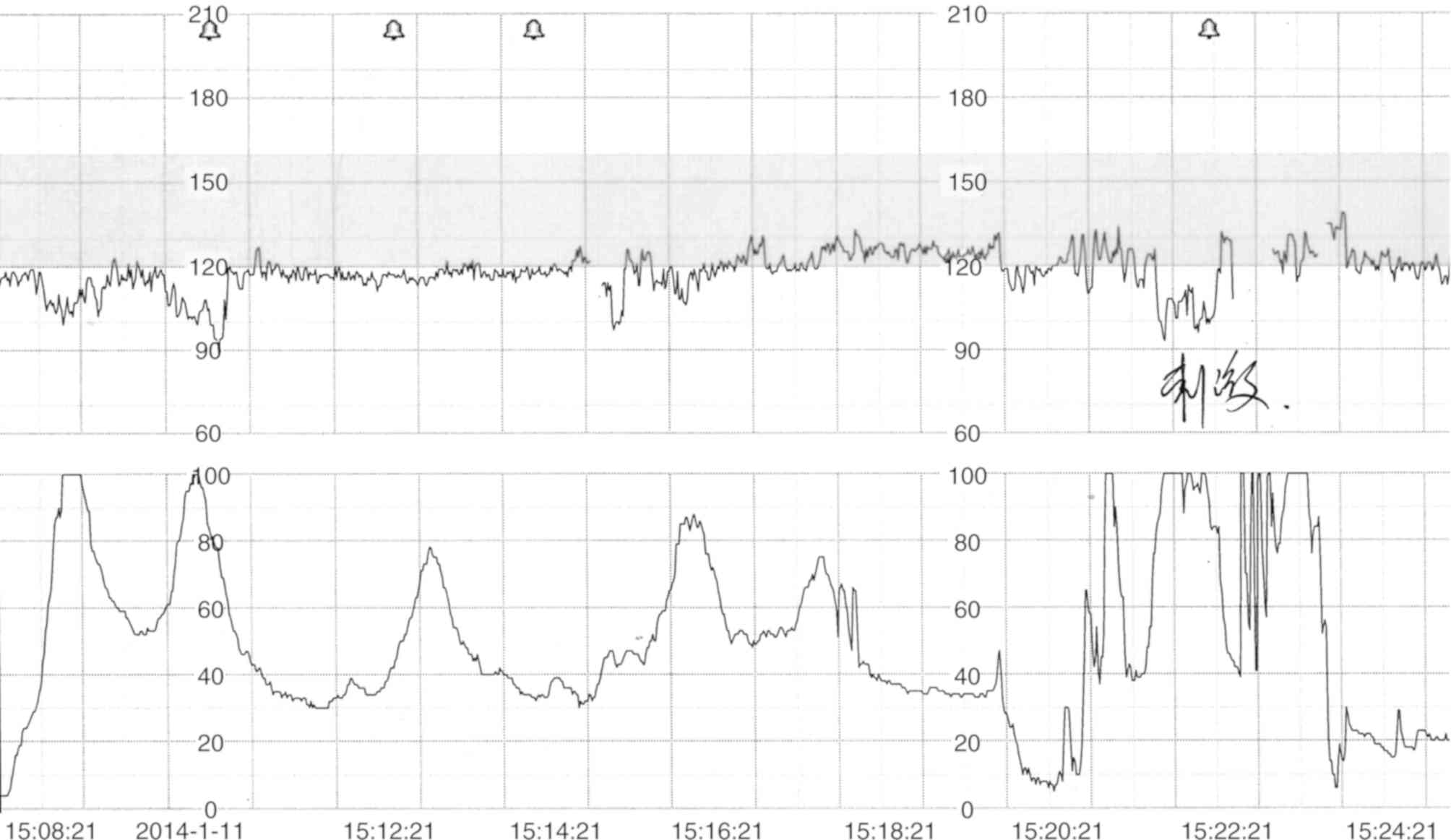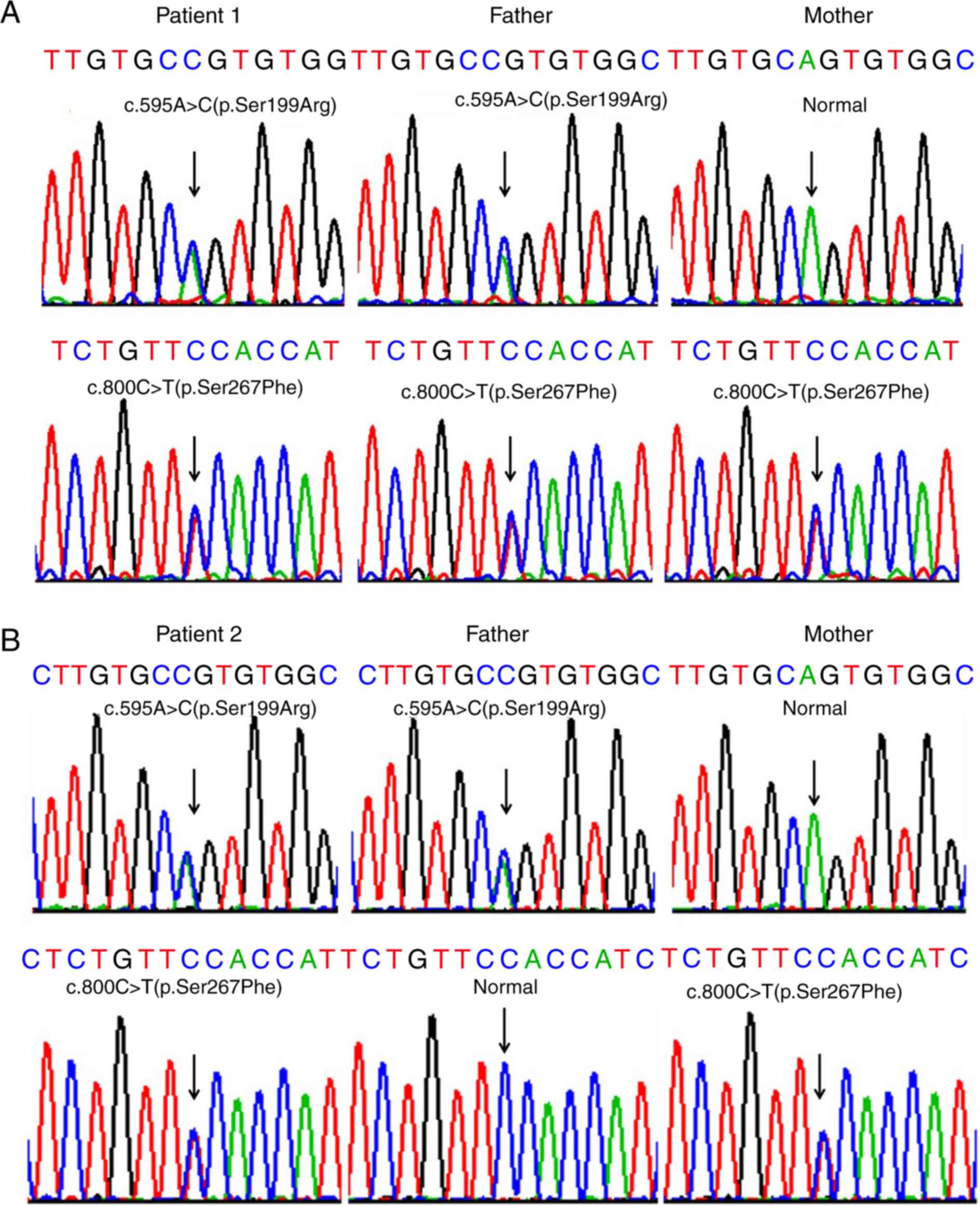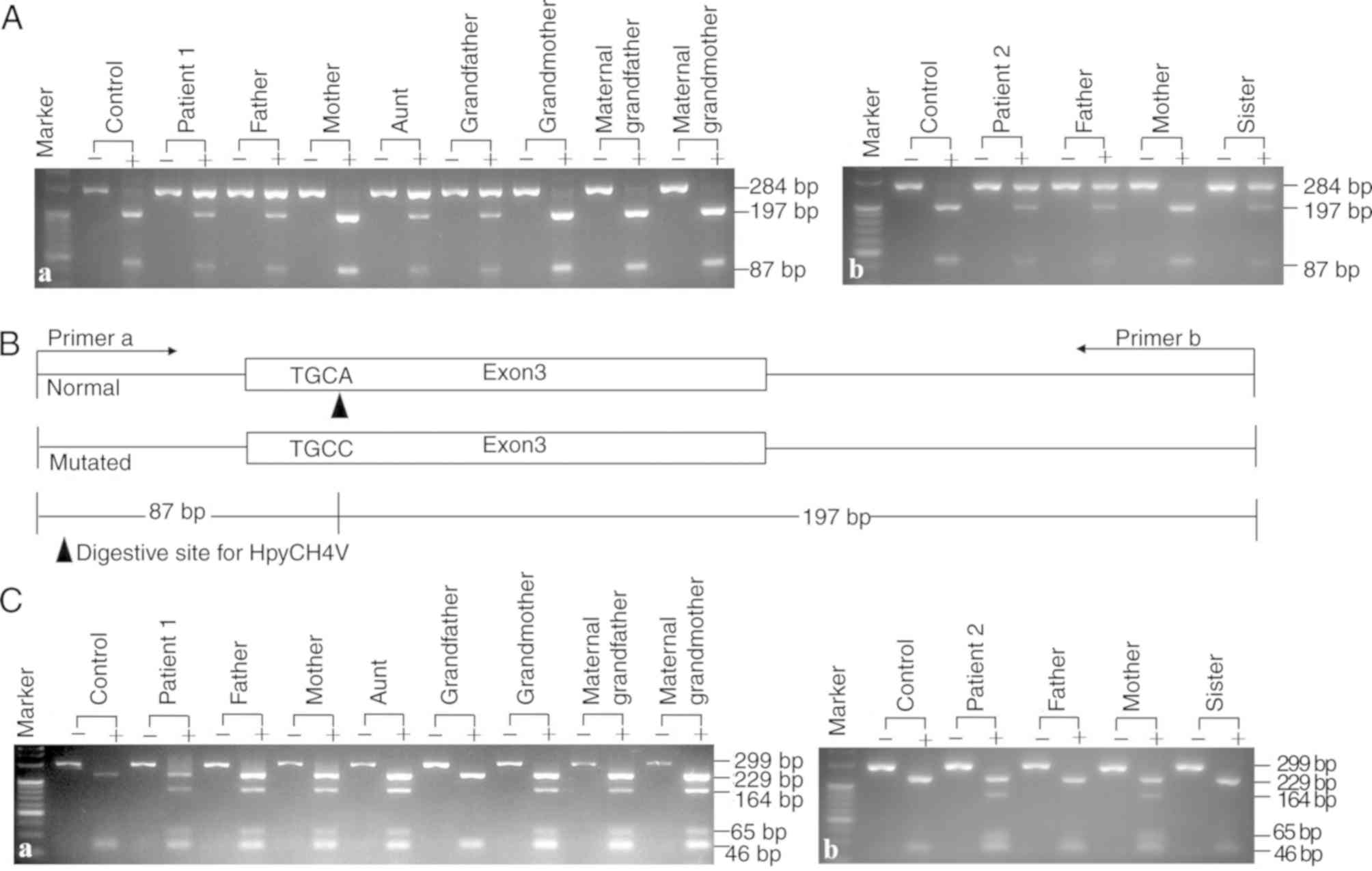|
1
|
Hagenbuch B and Meier PJ: Molecular
cloning, chromosomal localization, and functional characterization
of a human liver Na+/bile acid cotransporter. J Clin Invest.
93:1326–1331. 1994. View Article : Google Scholar : PubMed/NCBI
|
|
2
|
Shiao T, Iwahashi M, Fortune J, Quattrochi
L, Bowman S, Wick M, Qadri I and Simon FR: Structural and
functional characterization of liver cell-specific activity of the
human sodium/taurocholate cotransporter. Genomics. 69:203–213.
2000. View Article : Google Scholar : PubMed/NCBI
|
|
3
|
Anwer MS and Stieger B: Sodium-dependent
bile salt transporters of the SLC10A transporter family: More than
solute transporters. Pflugers Arch. 466:77–89. 2014. View Article : Google Scholar : PubMed/NCBI
|
|
4
|
Hagenbuch B and Dawson P: The sodium bile
salt cotransport family SLC10. Pflugers Arch. 447:566–570. 2004.
View Article : Google Scholar : PubMed/NCBI
|
|
5
|
Ho RH, Leake BF, Roberts RL, Lee W and Kim
RB: Ethnicity-dependent polymorphism in Na+-taurocholate
cotransporting polypeptide (SLC10A1) reveals a domain critical for
bile acid substrate recognition. J Biol Chem. 279:7213–7222. 2004.
View Article : Google Scholar : PubMed/NCBI
|
|
6
|
Pan W, Song IS, Shin HJ, Kim MH, Choi YL,
Lim SJ, Kim WY, Lee SS and Shin JG: Genetic polymorphisms in
Na+-taurocholate co-transporting polypeptide (NTCP) and
ileal apical sodium-dependent bile acid transporter (ASBT) and
ethnic comparisons of functional variants of NTCP among Asian
populations. Xenobiotica. 41:501–510. 2011. View Article : Google Scholar : PubMed/NCBI
|
|
7
|
Shneider BL, Fox VL, Schwarz KB, Watson
CL, Ananthanarayanan M, Thevananther S, Christie DM, Hardikar W,
Setchell KD, Mieli-Vergani G, et al: Hepatic basolateral
sodium-dependent-bile acid transporter expression in two unusual
cases of hypercholanemia and in extrahepatic biliary atresia.
Hepatology. 25:1176–1183. 1997. View Article : Google Scholar : PubMed/NCBI
|
|
8
|
Vaz FM, Paulusma CC, Huidekoper H, de Ru
M, Lim C, Koster J, Ho-Mok K, Bootsma AH, Groen AK, Schaap FG, et
al: Sodium taurocholate cotransporting polypeptide (SLC10A1)
deficiency: Conjugated hypercholanemia without a clear clinical
phenotype. Hepatology. 61:260–267. 2015. View Article : Google Scholar : PubMed/NCBI
|
|
9
|
Van Herpe F, Waterham HR, Adams CJ,
Mannens M, Bikker H, Vaz FM and Cassiman D: NTCP deficiency and
persistently raised bile salts: An adult case. J Inherit Metab Dis.
40:313–315. 2017. View Article : Google Scholar : PubMed/NCBI
|
|
10
|
Qiu JW, Deng M, Cheng Y, Atif RM, Lin WX,
Guo L, Li H and Song YZ: Sodium taurocholate cotransporting
polypeptide (NTCP) deficiency: Identification of a novel SLC10A1
mutation in two unrelated infants presenting with neonatal indirect
hyperbilirubinemia and remarkable hypercholanemia. Oncotarget.
8:106598–106607. 2017. View Article : Google Scholar : PubMed/NCBI
|
|
11
|
Liu R, Chen C, Xia X, Liao Q, Wang Q,
Newcombe PJ, Xu S, Chen M, Ding Y, Li X, et al: Homozygous
p.Ser267Phe in SLC10A1 is associated with a new type of
hypercholanemia and implications for personalized medicine. Sci
Rep. 7:92142017. View Article : Google Scholar : PubMed/NCBI
|
|
12
|
Deng M, Mao M, Guo L, Chen FP, Wen WR and
Song YZ: Clinical and molecular study of a pediatric patient with
sodium taurocholate cotransporting polypeptide deficiency. Exp Ther
Med. 12:3294–3300. 2016. View Article : Google Scholar : PubMed/NCBI
|
|
13
|
Song YZ and Deng M: Sodium taurocholate
cotransporting polypeptide deficiency manifesting as cholestatic
jaundice in early infancy: A complicated case study. Zhongguo Dang
Dai Er Ke Za Zhi. 19:350–354. 2017.(In Chinese). PubMed/NCBI
|
|
14
|
Li H, Qiu JW, Lin GZ, Deng M, Lin WX,
Cheng Y and Song YZ: Clinical and genetic analysis of a pediatric
patient with sodium taurocholate cotransporting polypeptide
deficiency. Zhongguo Dang Dai Er Ke Za Zhi. 20:279–284. 2018.(In
Chinese). PubMed/NCBI
|
|
15
|
Tan HJ, Deng M, Qiu JW, Wu JF and Song YZ:
Monozygotic twins suffering from sodium taurocholate cotransporting
polypeptide deficiency: A case report. Front Pediatr. 6:3542018.
View Article : Google Scholar : PubMed/NCBI
|
|
16
|
Chen R, Deng M, Rauf YM, Lin GZ, Qiu JW,
Zhu SY, Xiao XM and Song YZ: Intrahepatic cholestasis of pregnancy
as a clinical manifestation of sodium-taurocholate cotransporting
polypeptide deficiency. Tohoku J Exp Med. 248:57–61. 2019.
View Article : Google Scholar : PubMed/NCBI
|
|
17
|
Mao F, Liu T, Hou X, Zhao H, He W, Li C,
Jing Z, Sui J, Wang F, Liu X, et al: Increased sulfation of bile
acids in mice and human subjects with sodium taurocholate
cotransporting polypeptide deficiency. J Biol Chem.
294:11853–11862. 2019. View Article : Google Scholar : PubMed/NCBI
|
|
18
|
Adzhubei IA, Schmidt S, Peshkin L,
Ramensky VE, Gerasimova A, Bork P, Kondrashov AS and Sunyaev SR: A
method and server for predicting damaging missense mutations. Nat
Methods. 7:248–249. 2010. View Article : Google Scholar : PubMed/NCBI
|
|
19
|
Bacalhau M, Pratas J, Simoes M, Mendes C,
Ribeiro C, Santos MJ, Diogo L, Macario MC and Grazina M: In silico
analysis for predicting pathogenicity of five unclassified
mitochondrial DNA mutations associated with mitochondrial
cytopathies' phenotypes. Eur J Med Genet. 60:172–177. 2017.
View Article : Google Scholar : PubMed/NCBI
|
|
20
|
Kumar P, Henikoff S and Ng PC: Predicting
the effects of coding non-synonymous variants on protein function
using the SIFT algorithm. Nat Protoc. 4:1073–1081. 2009. View Article : Google Scholar : PubMed/NCBI
|
|
21
|
Quang D, Chen Y and Xie X: DANN: A deep
learning approach for annotating the pathogenicity of genetic
variants. Bioinformatics. 31:761–763. 2015. View Article : Google Scholar : PubMed/NCBI
|
|
22
|
Richards S, Aziz N, Bale S, Bick D, Das S,
Gastier-Foster J, Grody WW, Hegde M, Lyon E, Spector E, et al:
Standards and guidelines for the interpretation of sequence
variants: A joint consensus recommendation of the American college
of medical genetics and genomics and the association for molecular
pathology. Genet Med. 17:405–424. 2015. View Article : Google Scholar : PubMed/NCBI
|
|
23
|
Hicks S, Wheeler DA, Plon SE and Kimmel M:
Prediction of missense mutation functionality depends on both the
algorithm and sequence alignment employed. Hum Mutat. 32:661–668.
2011. View Article : Google Scholar : PubMed/NCBI
|
|
24
|
Nykamp K, Anderson M, Powers M, Garcia J,
Herrera B, Ho YY, Kobayashi Y, Patil N, Thusberg J, Westbrook M, et
al: Sherloc: A comprehensive refinement of the ACMG-AMP variant
classification criteria. Genet Med. 19:1105–1117. 2017. View Article : Google Scholar : PubMed/NCBI
|
|
25
|
Hagenbuch B and Meier PJ: The superfamily
of organic anion transporting polypeptides. Biochim Biophys Acta.
1609:1–18. 2003. View Article : Google Scholar : PubMed/NCBI
|
|
26
|
Mooij MG, Schwarz UI, de Koning BA, Leeder
JS, Gaedigk R, Samsom JN, Spaans E, van Goudoever JB, Tibboel D,
Kim RB and de Wildt SN: Ontogeny of human hepatic and intestinal
transporter gene expression during childhood: Age matters. Drug
Metab Dispos. 42:1268–1274. 2014. View Article : Google Scholar : PubMed/NCBI
|
|
27
|
Ballatori N, Christian WV, Lee JY, Dawson
PA, Soroka CJ, Boyer JL, Madejczyk MS and Li N: OSTalpha-OSTbeta: A
major basolateral bile acid and steroid transporter in human
intestinal, renal and biliary epithelia. Hepatology. 42:1270–1279.
2005. View Article : Google Scholar : PubMed/NCBI
|
|
28
|
Goodwin B, Jones SA, Price RR, Watson MA,
McKee DD, Moore LB, Galardi C, Wilson JG, Lewis MC, Roth ME, et al:
A regulatory cascade of the nuclear receptors FXR, SHP-1, and LRH-1
represses bile acid biosynthesis. Mol Cell. 6:517–526. 2000.
View Article : Google Scholar : PubMed/NCBI
|
|
29
|
Boyer JL, Trauner M, Mennone A, Soroka CJ,
Cai SY, Moustafa T, Zollner G, Lee JY and Ballatori N: Upregulation
of a basolateral FXR-dependent bile acid efflux transporter
OSTalpha-OSTbeta in cholestasis in humans and rodents. Am J Physiol
Gastrointest Liver Physiol. 290:G1124–G1130. 2006. View Article : Google Scholar : PubMed/NCBI
|
|
30
|
Frankenberg T, Rao A, Chen F, Haywood J,
Shneider BL and Dawson PA: Regulation of the mouse organic solute
transporter alpha-beta, Ostalpha-Ostbeta, by bile acids. Am J
Physiol Gastrointest Liver Physiol. 290:G912–G922. 2006. View Article : Google Scholar : PubMed/NCBI
|
|
31
|
Landrier JF, Eloranta JJ, Vavricka SR and
Kullak-Ublick GA: The nuclear receptor for bile acids, FXR,
transactivates human organic solute transporter-alpha and -beta
genes. Am J Physiol Gastrointest Liver Physiol. 290:G476–G485.
2006. View Article : Google Scholar : PubMed/NCBI
|
|
32
|
Tom Lissauer and Will Carroll: Illustrated
textbook of paediatricsElsevier; Amsterdam: pp. 2572018
|
|
33
|
Ignjatovic V, Lai C, Summerhayes R,
Mathesius U, Tawfilis S, Perugini MA and Monagle P: Age-related
differences in plasma proteins: How plasma proteins change from
neonates to adults. PLoS One. 6:e172132011. View Article : Google Scholar : PubMed/NCBI
|
|
34
|
Robert M, Kliegman, Behrman, Jenson and
Stanton: Nelson textbook of pediatricsSaunders; Philadelphia: pp.
16602007
|
|
35
|
Suchy FJ, Balistreri WF, Heubi JE, Searcy
JE and Levin RS: Physiologic cholestasis: Elevation of the primary
serum bile acid concentrations in normal infants. Gastroenterology.
80:1037–1041. 1981. View Article : Google Scholar : PubMed/NCBI
|
|
36
|
Balistreri WF, Suchy FJ, Farrell MK and
Heubi JE: Pathologic versus physiologic cholestasis: Elevated serum
concentration of a secondary bile acid in the presence of
hepatobiliary disease. J Pediatr. 98:399–402. 1981. View Article : Google Scholar : PubMed/NCBI
|
|
37
|
Kawasaki H, Yamanishi Y, Miyake M, Mura T
and Ikawa S: Age- and sex-related profiles of serum primary and
total bile acids in infants, children and adults. Tohoku J Exp Med.
150:353–357. 1986. View Article : Google Scholar : PubMed/NCBI
|
|
38
|
Sargiacomo C, El-Kehdy H, Pourcher G,
Stieger B, Najimi M and Sokal E: Age-dependent glycosylation of the
sodium taurocholate cotransporter polypeptide: From fetal to adult
human livers. Hepatol Commun. 2:693–702. 2018. View Article : Google Scholar : PubMed/NCBI
|
|
39
|
Colombo C, Zuliani G, Ronchi M,
Breidenstein J and Setchell KD: Biliary bile acid composition of
the human fetus in early gestation. Pediatr Res. 21:197–200. 1987.
View Article : Google Scholar : PubMed/NCBI
|
|
40
|
Colombo C, Roda A, Roda E, Buscaglia M,
dell'Agnola CA, Filippetti P, Ronchi M and Sereni F: Correlation
between fetal and maternal serum bile acid concentrations. Pediatr
Res. 19:227–231. 1985. View Article : Google Scholar : PubMed/NCBI
|
|
41
|
Itoh S, Onishi S, Isobe K, Manabe M and
Inukai K: Foetomaternal relationships of serum bile acid pattern
estimated by high-pressure liquid chromatography. Biochem J.
204:141–145. 1982. View Article : Google Scholar : PubMed/NCBI
|
|
42
|
Monte MJ, Rodriguez-Bravo T, Macias RI,
Bravo P, el-Mir MY, Serrano MA, Lopez-Salva A and Marin JJ:
Relationship between bile acid transplacental gradients and
transport across the fetal-facing plasma membrane of the human
trophoblast. Pediatr Res. 38:156–163. 1995. View Article : Google Scholar : PubMed/NCBI
|














